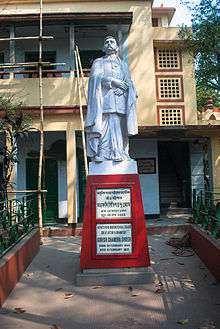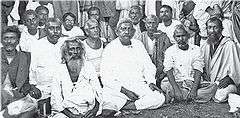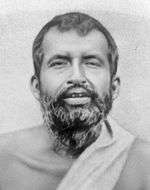Girish Chandra Ghosh
Girish Chandra Ghosh (28 February 1844 – 8 February 1912) was a Bengali actor, director, and writer. He was largely responsible for the golden age of Bengali theatre.[1][2][3] He cofounded the Great National Theatre, the first Bengali professional theatre company in 1872, wrote nearly 40 plays and acted and directed many more,[4] and later in life became a noted disciple of Sri Ramakrishna.[5]

Girish Chandra Ghosh | |
|---|---|
| Born | 28 February 1844 |
| Died | 8 February 1912 (aged 67) |
| Citizenship | British Indian |
| Alma mater | Hare school Oriental Seminary |
| Occupation | Actor, director, and writer |
| Spouse(s) | Pramodini Devi |
Biography

Early days
Born in Bagbazar, Kolkata, on 28 February 1844, the eighth child to his parents Nilkamal and Raimani, he received his early education at Oriental Seminary, and later studied at Hare School in the city but not completed education. After the death of his father he married Promodini Devi, the daughter of Nabin Chandra Deb and re-entered in class - I in Oriental Seminary. His father Nilkamal Ghosh was a generous and kind hearted person and Girish retained some of his father's large heartedness. He lost his parents early in life and went up to educate himself. Girish after leaving school in 1862 acquired an apprenticeship with a British Company in book keeping. It was around this time that Girish became acquainted with Ishwar Chandra Gupta and began writing plays, songs and poetry.[6]
Professional career
Girish was a prominent actor in the Bagbazar Amateur Theatre where he had Ardhendu Sekhar Mustafi, another great contemporary actor, as his partner. Together they performed in Sadhabar Ekadashi by the famous playwright Dinabandhu Mitra, which became very popular. Later Bagbazar Amateur was renamed in 1871 as the National Theatre. Girish however left National Theatre and went to form the Great National Theatre in 1873 which he became manager of in 1880. In 1877 Girish staged his first play Agamani at The Great National Theatre.[6] Later he also worked in Minerva Theatre and went to become a manager in Star Theatre. The maiden show at the Star Theatre was Daksha Jagna by Girish Chandra Ghosh on the auspicious day of 21 July 1883. With Binodini Dasi, he staged his play, Chaitanyalila, at the Star Theatre on 20 September 1884, with, Sri Ramakrishna in the audience. Girish wrote about 86 plays, most of which were based upon stories from Purana, Ramayana and Mahabharata. Among his famous works were Buddhadev Charit, Purna Chandra, Nasiram, Kalapahar, Ashoka, Shankaracharya, Chaitanyalila, Nimai Sannyas, Rup-Sanatan, Vilwamangal, Prahlad Charit. Most of his plays were performed in Star Theatre in Calcutta.[7] Girish also translated Shakespeare's Macbeth play into Bangla in 1893.[6]
Influence of Sri Ramakrishna
Girish first met Sri Ramakrishna in the ancestral home of his neighbour Kalinath Bose. On 21 September 1884 Sri Ramakrishna went to watch Chaitanya Lila in Star Theatre. It is said that Girish's first meeting with Sri Ramakrishna, was not very cordial. He saw Sri Ramakrishna in divine ecstasy and thought it to be some kind of a trick. But later when Ramakrishna met him the Master told him that the incident was no trick and Girish was extremely surprised to find master reading his thought. Later when the Master went to watch his theatre he and Girish repeatedly went on exchanging salutes and ultimately Girish had to give up. Girish later said about this incident that in Iron Age the best weapon is "pranamastra" or the "salute weapon" with which god kills His enemies. In his play Nasiram, Girish used much of the teachings of Sri Ramakrishna.[8] There are many scenes in The Gospel of Sri Ramakrishna involving Girish and Sri Ramakrishna. Sri Ramakrishna went to watch several of his plays in Star Theatre. He also blessed Binodini Dasi, one of the lead actresses.
References
- Nalini Natarajan; Emmanuel Sampath Nelson (1996). "Drama 1900 -1926". Handbook of twentieth-century literatures of India. Greenwood Publishing Group. p. 48. ISBN 0313287783.
- Kundu, Pranay K. Development of Stage and Theatre Music in Bengal. Published in Banerjee, Jayasri (ed.), The Music of Bengal. Baroda: Indian Musicological Society, 1987.
- Sisir Kumar Das (1991). History of Indian Literature: 1800–1910 : Western Impact, British Response. Sahitya Akademi. p. 283. ISBN 8172010060.
- "Girish Chandra Ghosh". Encyclopædia Britannica.
- Christopher Isherwood (1980). Ramakrishna and his disciples. Vedanta Press. p. 247. ISBN 087481037X.
- "Ghosh, Girish Chandra". Banglapedia. Retrieved 4 February 2017.
- Girish Chandra Ghosh Archived 19 February 2012 at the Wayback Machine
- Contemporary Bengali Literature – I, by Hiranmoy Mukherjee, Vedanta Kesari, April 2010
Further reading
- From The Undivine Tree to the Divine Fruit: Girish Chandra Ghosh by Sri Chinmoy, 1991. Online
- Girish Chandra Ghosh, by Utpal Dutta. Published by Sahitya Akademi, 1992. ISBN 8172011970. Online
- Girish Chandra Ghosh, by Swami Chetanananda, Copyright 2009 Vedanta Society of St. Louis, ISBN 978-0-916356-92-7
